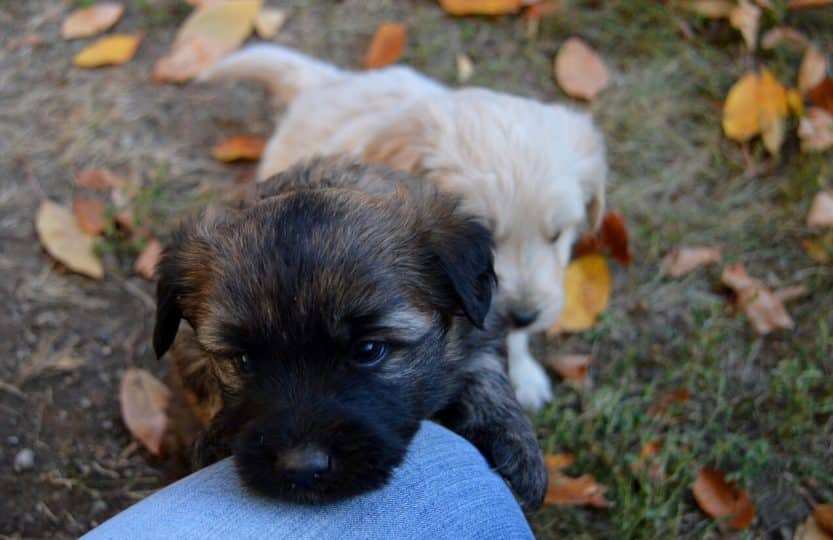As the parent of a new (and rapidly growing) puppy, you might have one major question: “How can I calculate my puppy’s size and growth?”
Your puppy’s growth rate will affect more than their ability to fit on your lap. It can also have an impact on their ideal diet, exercise requirements, and more.
While there’s no specific formula or puppy size calculator guaranteed to make an accurate prediction, we do have some expert guidance to help you estimate your dog’s final adult size based on their current age, weight, and breed.
If you’re curious to peek into the future, read on to get more details, along with some other tips on caring for a growing dog.
How To Estimate Your Puppy’s Adult Size
“Unfortunately, there is no universal magic formula to predict adult weight,” says Dr Genna Mize, DVM.
Some puppy size calculators suggest doubling your puppy’s weight at 16 weeks—but given the variances in breed and growth rates (larger breeds will typically mature later), there’s no “one size fits all” approach, according to Dr Mize.
If you got your puppy from a breeder, a good way to get an estimate of their adult size is to ask about the size of your puppy’s parents, Dr Mize suggests. Many breeders even provide growth charts to help you track your puppy’s growth.
For adopted mixed breed dogs with unknown parents, you may have a harder time predicting their adult size, Dr Mize says—but you can always check out your pup’s paws to get a better idea of how big they’ll become. Larger breeds will have bigger paws and bigger lower leg joints.
Just keep in mind your dog’s individual growth path may vary. Most dog breeds generally have a standard weight, but variations in your dog’s genes could play a role in their final size. For example, if your dog’s parents both had a smaller size than the breed average, it stands to reason that your dog may also have a smaller adult size.
That’s why calculators and formulas can’t always make accurate predictions. They don’t know your pup personally, and they can’t account for any unique genetic variations.
How Big Will Your Dog Be? Two Useful Growth Charts
Ever wondered why there’s such a massive difference in size between different dog breeds? That’s mainly down to selective breeding, or breeding designed to bring out certain characteristics. For example, the tiny Dachshund was bred low to the ground to hunt badgers, while German Shepherds needed to have a larger size to protect flocks of sheep from predators.
The size group your dog falls into plays a major part in their final weight and height. Check out the puppy growth charts below to get an idea of your dog’s adult size.
A dog’s final weight chart for every size group
| Dog Size Group | Final Weight |
| Toy | 1kg-6kg (2.2lbs-13.2lbs) |
| Small | 6kg-10kg (13.2lbs-22lbs) |
| Medium | 10kg-28kg (22lbs-55.1lbs) |
| Large | 28+kg (55.1lbs-99lbs) |
| Giant | 45+kg (99+lbs) |
A dog’s final height chart for every size group
| Dog Size Group | Final Height |
| Toy | 15cm to 28cm (6in-11in) |
| Small | 25.5cm to 43cm (10in-17in) |
| Medium | 43cm to 63.5cm (17in-25in) |
| Large | 58.5cm to 68.5cm (23in-27in) |
| Giant | 68.5cm to 81cm (27in-32in) |
What Other Factors Affect A Dog’s Growth?
Sometimes, variations in your dog’s growth may also relate to factors like:
- Genes: our dogs can inherit genetic markers from their parents that affect their size. Researchers estimate these genotypes may account for over 64% of weight variations in dogs.
- Sex: on average, male dogs are usually larger than females.
- Neutering: while spaying and neutering your puppy is an important step in responsible pet ownership, the timing could affect your dog’s overall growth. One study linked neutering later in life (after 37 weeks) to slightly less growth.
However, if your dog is bigger or smaller than expected, this could also indicate an underlying health concern, says Dr Preston Turano, vet and AKC Pet Insurance spokesperson.
Potential health issues that could affect your dog’s growth include:
- Malnutrition: “A healthy and appropriate diet will have a major effect on a puppy’s development,” Dr Turano says. A diet without adequate calories and nutrition could cause a failure to grow.
- Parasites: certain parasites, like roundworms, could cause a lack of growth.
- Portosystemic shunts (PSS): these abnormal connections between some of your dog’s internal organs may also stunt their growth.
- Dwarfism: some dogs can inherit pituitary dwarfism, a condition that causes growth hormone deficiency and may stunt growth.
According to Dr Turano, your dog should visit the vet regularly between the ages of four and six months old. You can discuss any variations in your dog’s expected weight with your vet, who can check for signs of any underlying health concerns.
How to Care For A Growing Dog
Beyond regular vet visits, you can support your puppy’s growth by feeding them a balanced diet designed for growing dogs. Just keep in mind that different breeds might need food specially designed for dogs in their size range.
For example, large and giant dogs need puppy food that helps keep their growth slow and steady, says Dr Gary Richter, Rover’s resident veterinarian.
If large and giant dogs grow too fast and too soon, they have a greater risk for hip and elbow dysplasia when they get older. Smaller breeds don’t have the same issue, since they don’t grow as rapidly or as much overall, Dr Richter says.
Helping your dog stay active can also benefit their health as they grow. That said, puppies have less stamina than fully grown dogs, which means they need shorter play sessions and more frequent breaks. Keeping the exercise requirements for your puppy’s breed in mind—and paying close attention to signs they’re getting tired—can help prevent potential injuries.
For instance, a dog like a Jack Russell Terrier might need to run for hours, whereas a Shih Tzu may be content with 30 minutes of exercise, Dr Richter says.
How to Know When Your Dog Is Fully Grown
In general, the larger your dog, the longer it will take for them to reach their final adult size. The chart below shows the average time your dog will reach their full growth.
| Dog Group Size | Final Size | Age |
| Toy | 1kg-6kg (2.2lbs-13.2lbs) | 6 months-8 months |
| Small | 6kg-10kg (13.2lbs-22lbs) | 6 months-8 months |
| Medium | 10kg-25kg (22lbs-55.1lbs) | 9 months-10 months |
| Large | 25kg-45kg (55.1lbs-99lbs) | 11 months-15 months |
| Giant | 45+kg (99+lbs) | 15 months-24 months |
And of course, your puppy will need plenty of support at every stage of their growth, no matter their final size—and giving them plenty of love can go a long way toward helping them stay happy and healthy!





